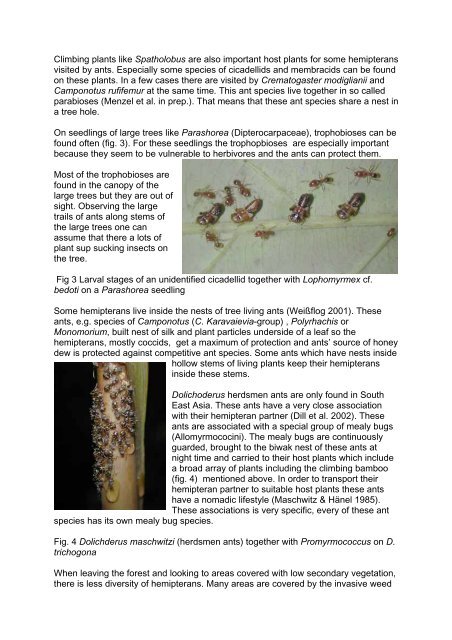Trophobioses between ants and hemipterans - AntBase.net
Trophobioses between ants and hemipterans - AntBase.net
Trophobioses between ants and hemipterans - AntBase.net
You also want an ePaper? Increase the reach of your titles
YUMPU automatically turns print PDFs into web optimized ePapers that Google loves.
Climbing pl<strong>ants</strong> like Spatholobus are also important host pl<strong>ants</strong> for some <strong>hemipterans</strong><br />
visited by <strong>ants</strong>. Especially some species of cicadellids <strong>and</strong> membracids can be found<br />
on these pl<strong>ants</strong>. In a few cases there are visited by Crematogaster modiglianii <strong>and</strong><br />
Camponotus rufifemur at the same time. This ant species live together in so called<br />
parabioses (Menzel et al. in prep.). That means that these ant species share a nest in<br />
a tree hole.<br />
On seedlings of large trees like Parashorea (Dipterocarpaceae), trophobioses can be<br />
found often (fig. 3). For these seedlings the trophopbioses are especially important<br />
because they seem to be vulnerable to herbivores <strong>and</strong> the <strong>ants</strong> can protect them.<br />
Most of the trophobioses are<br />
found in the canopy of the<br />
large trees but they are out of<br />
sight. Observing the large<br />
trails of <strong>ants</strong> along stems of<br />
the large trees one can<br />
assume that there a lots of<br />
plant sup sucking insects on<br />
the tree.<br />
Fig 3 Larval stages of an unidentified cicadellid together with Lophomyrmex cf.<br />
bedoti on a Parashorea seedling<br />
Some <strong>hemipterans</strong> live inside the nests of tree living <strong>ants</strong> (Weißflog 2001). These<br />
<strong>ants</strong>, e.g. species of Camponotus (C. Karavaievia-group) , Polyrhachis or<br />
Monomorium, built nest of silk <strong>and</strong> plant particles underside of a leaf so the<br />
<strong>hemipterans</strong>, mostly coccids, get a maximum of protection <strong>and</strong> <strong>ants</strong>’ source of honey<br />
dew is protected against competitive ant species. Some <strong>ants</strong> which have nests inside<br />
hollow stems of living pl<strong>ants</strong> keep their <strong>hemipterans</strong><br />
inside these stems.<br />
Dolichoderus herdsmen <strong>ants</strong> are only found in South<br />
East Asia. These <strong>ants</strong> have a very close association<br />
with their hemipteran partner (Dill et al. 2002). These<br />
<strong>ants</strong> are associated with a special group of mealy bugs<br />
(Allomyrmococini). The mealy bugs are continuously<br />
guarded, brought to the biwak nest of these <strong>ants</strong> at<br />
night time <strong>and</strong> carried to their host pl<strong>ants</strong> which include<br />
a broad array of pl<strong>ants</strong> including the climbing bamboo<br />
(fig. 4) mentioned above. In order to transport their<br />
hemipteran partner to suitable host pl<strong>ants</strong> these <strong>ants</strong><br />
have a nomadic lifestyle (Maschwitz & Hänel 1985).<br />
These associations is very specific, every of these ant<br />
species has its own mealy bug species.<br />
Fig. 4 Dolichderus maschwitzi (herdsmen <strong>ants</strong>) together with Promyrmococcus on D.<br />
trichogona<br />
When leaving the forest <strong>and</strong> looking to areas covered with low secondary vegetation,<br />
there is less diversity of <strong>hemipterans</strong>. Many areas are covered by the invasive weed




